智能红外传感器AS612
- 格式:pdf
- 大小:894.21 KB
- 文档页数:8
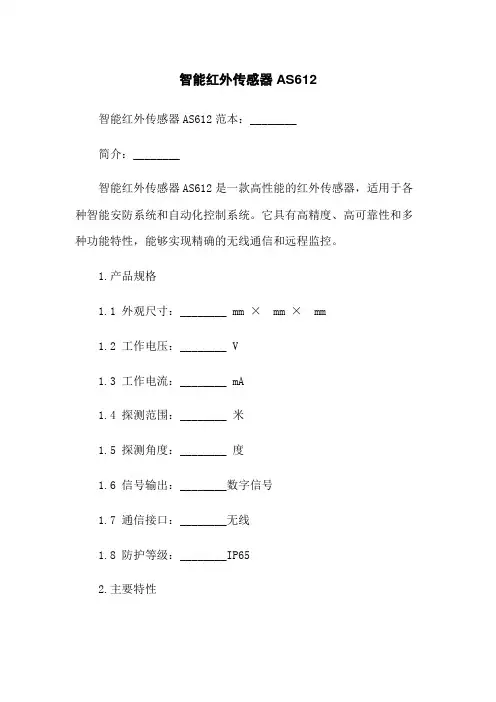
智能红外传感器AS612智能红外传感器AS612范本:________简介:________智能红外传感器AS612是一款高性能的红外传感器,适用于各种智能安防系统和自动化控制系统。
它具有高精度、高可靠性和多种功能特性,能够实现精确的无线通信和远程监控。
1.产品规格1.1 外观尺寸:________ mm × mm × mm1.2 工作电压:________ V1.3 工作电流:________ mA1.4 探测范围:________ 米1.5 探测角度:________ 度1.6 信号输出:________数字信号1.7 通信接口:________无线1.8 防护等级:________IP652.主要特性2.1 高精度测量:________采用先进的红外技术,实现对目标物体的准确测量。
2.2 高可靠性:________具有稳定的性能指标和长寿命,适用于各种复杂环境。
2.3 多种功能特性:________支持远程监控、人体检测、温度测量等多种功能。
2.4 灵活性:________可根据用户需求进行定制配置,方便集成到不同的系统中。
2.5 易安装与维护:________采用标准接口和简单的安装步骤,操作简便。
3.使用说明3.1 安装方式:________将AS612固定在所需位置,确保传感器正面朝向待测物体。
3.2 上电:________连接合适的电源,确保工作电压符合规格要求。
3.3 参数配置:________通过无线通信接口,根据需要配置传感器的参数,包括探测范围、角度等。
3.4 功能调试:________通过远程监控或相关软件,对传感器的功能进行调试和测试。
3.5 维护保养:________定期清理灰尘和污垢,并检查连接线路是否正常。
4.警告与注意事项4.1 用户必须仔细阅读和理解本文档,并严格按照操作说明进行操作。
4.2 在使用过程中,应避免将AS612暴露在高温、潮湿等恶劣环境中。
![智能红外传感器AS612[1]](https://uimg.taocdn.com/f26dc584fc0a79563c1ec5da50e2524de518d0bc.webp)
智能红外传感器AS612智能红外传感器AS612智能红外传感器AS612是一种高性能的红外线(IR)探测器,采用先进的传感技术和智能算法,能够准确地检测和识别物体的移动。
AS612广泛应用于安防系统、智能家居、自动化控制等领域,提供可靠、精确、高效的移动检测解决方案。
特点与优势1. 高度灵敏:AS612采用先进的红外技术,能够高度敏感地检测到物体的移动,无论是静止的目标还是快速移动的物体。
2. 宽波动范围:AS612在工作频率范围内具有较大的探测角度,可以覆盖更广泛的区域,提供更全面的监测能力。
3. 低功耗设计:AS612采用低功耗设计,不仅可以减少能源消耗,延长电池使用寿命,还有助于减少对环境的影响。
4. 可靠性和稳定性:AS612具有出色的抗干扰能力,能够在多种复杂环境下稳定工作,减少误报和漏报的可能性。
5. 智能算法支持:AS612内置先进的智能算法,能够实现人体检测、烟雾检测、扰动检测等功能,提供更多应用场景的支持。
6. 易于安装和使用:AS612的设计紧凑而简洁,安装方便快捷。
用户只需按照说明书将传感器正确安装在需要监测的位置即可。
技术规格以下是AS612智能红外传感器的一些关键技术规格:- 工作电压:3V- 静态工作电流:≤50uA- 工作温度:-20°C至60°C- 探测距离:0-5m(可自定义调节)- 探测角度:120°- 输出电平:高电平(3V)/低电平(0V)- 输出方式:脉冲输出- 尺寸:25mm x 12mm x 10mm应用场景AS612智能红外传感器可以广泛应用于各种场景,包括但不限于以下几个方面:1. 安防系统AS612能够快速准确地检测到移动物体,可以应用于安防系统,实现入侵检测、区域监控等功能。
当AS612检测到有人或物体进入监控区域时,会触发报警系统,及时通知相关人员。
2. 智能家居AS612可以集成到智能家居系统中,用于检测居民的活动。
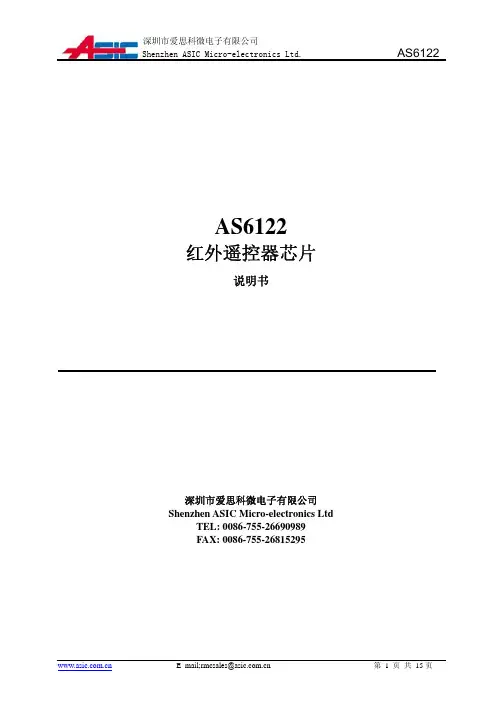
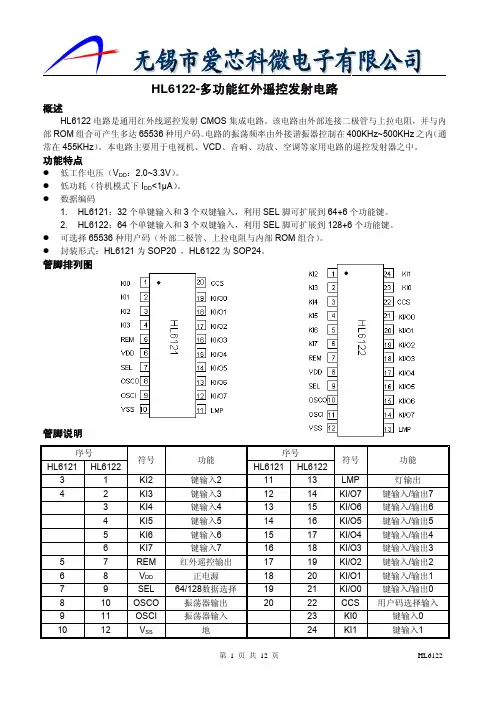
HL6122-多功能红外遥控发射电路概述HL6122电路是通用红外线遥控发射CMOS集成电路。
该电路由外部连接二极管与上拉电阻,并与内部ROM组合可产生多达65536种用户码。
电路的振荡频率由外接谐振器控制在400KHz~500KHz之内(通常在455KHz)。
本电路主要用于电视机、VCD、音响、功放、空调等家用电路的遥控发射器之中。
功能特点z低工作电压(V DD:2.0~3.3V)。
z低功耗(待机模式下I DD<1μA)。
z数据编码1.HL6121:32个单键输入和3个双键输入,利用SEL脚可扩展到64+6个功能键。
2.HL6122:64个单键输入和3个双键输入,利用SEL脚可扩展到128+6个功能键。
z可选择65536种用户码(外部二极管、上拉电阻与内部ROM组合)。
z封装形式:HL6121为SOP20,HL6122为SOP24。
管脚排列图管脚说明序号符号功能序号符号功能HL6121HL6122HL6121HL612231KI2键输入21113LMP灯输出42KI3键输入31214KI/O7键输入/输出7 3KI4键输入41315KI/O6键输入/输出64KI5键输入51416KI/O5键输入/输出55KI6键输入61517KI/O4键输入/输出46KI7键输入71618KI/O3键输入/输出3 57REM红外遥控输出1719KI/O2键输入/输出2 68V DD正电源1820KI/O1键输入/输出1 79SEL64/128数据选择1921KI/O0键输入/输出0 810OSCO振荡器输出2022CCS用户码选择输入911OSCI振荡器输入23KI0键输入0 1012V SS地24KI1键输入1功能框图*:HL6121KI0~KI3HL6122KI0~KI7HL6121和HL6122功能比较功能说明1.引脚功能:(1)键输入管脚(HL6121为KI0~KI3,HL6122为KI0~KI7),键输入/输出管脚(KI/O0~KI/O7)在键输入管脚和V SS之间有一个下拉电阻。
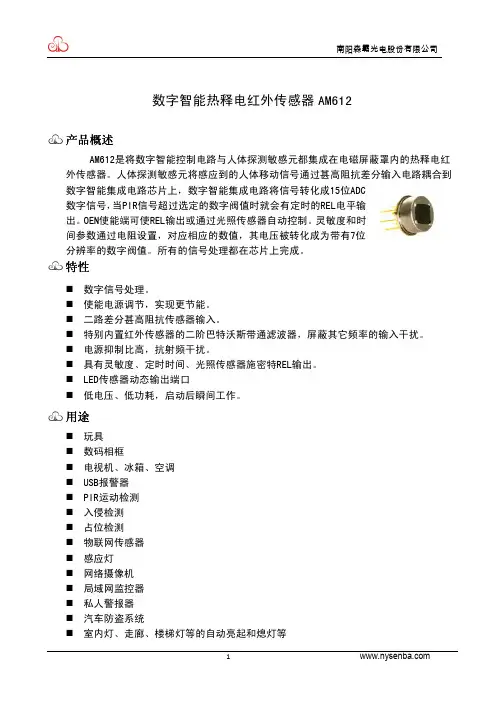
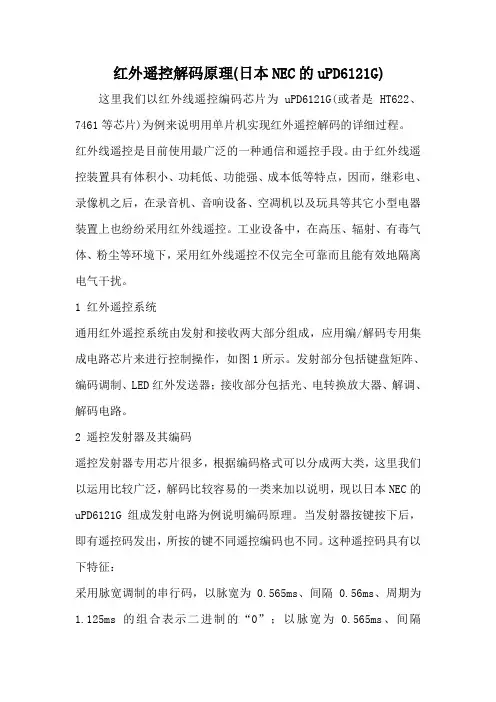
红外遥控解码原理(日本NEC的uPD6121G)这里我们以红外线遥控编码芯片为uPD6121G(或者是 HT622、7461等芯片)为例来说明用单片机实现红外遥控解码的详细过程。
红外线遥控是目前使用最广泛的一种通信和遥控手段。
由于红外线遥控装置具有体积小、功耗低、功能强、成本低等特点,因而,继彩电、录像机之后,在录音机、音响设备、空凋机以及玩具等其它小型电器装置上也纷纷采用红外线遥控。
工业设备中,在高压、辐射、有毒气体、粉尘等环境下,采用红外线遥控不仅完全可靠而且能有效地隔离电气干扰。
1 红外遥控系统通用红外遥控系统由发射和接收两大部分组成,应用编/解码专用集成电路芯片来进行控制操作,如图1所示。
发射部分包括键盘矩阵、编码调制、LED红外发送器;接收部分包括光、电转换放大器、解调、解码电路。
2 遥控发射器及其编码遥控发射器专用芯片很多,根据编码格式可以分成两大类,这里我们以运用比较广泛,解码比较容易的一类来加以说明,现以日本NEC的uPD6121G组成发射电路为例说明编码原理。
当发射器按键按下后,即有遥控码发出,所按的键不同遥控编码也不同。
这种遥控码具有以下特征:采用脉宽调制的串行码,以脉宽为0.565ms、间隔0.56ms、周期为1.125ms的组合表示二进制的“0”;以脉宽为0.565ms、间隔1.685ms、周期为2.25ms的组合表示二进制的“1”,其波形如图2所示。
上述“0”和“1”组成的32位二进制码经38kHz的载频进行二次调制以提高发射效率,达到降低电源功耗的目的。
然后再通过红外发射二极管产生红外线向空间发射,如图3所示。
UPD6121G产生的遥控编码是连续的32位二进制码组,其中前16位为用户识别码,能区别不同的电器设备,防止不同机种遥控码互相干扰。
该芯片的用户识别码固定为十六进制01H;后16位为8位操作码(功能码)及其反码。
UPD6121G最多额128种不同组合的编码。
遥控器在按键按下后,周期性地发出同一种32位二进制码,周期约为108ms。
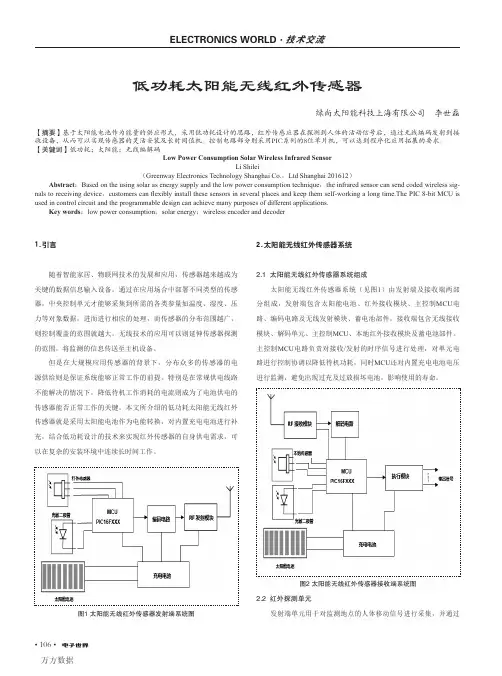
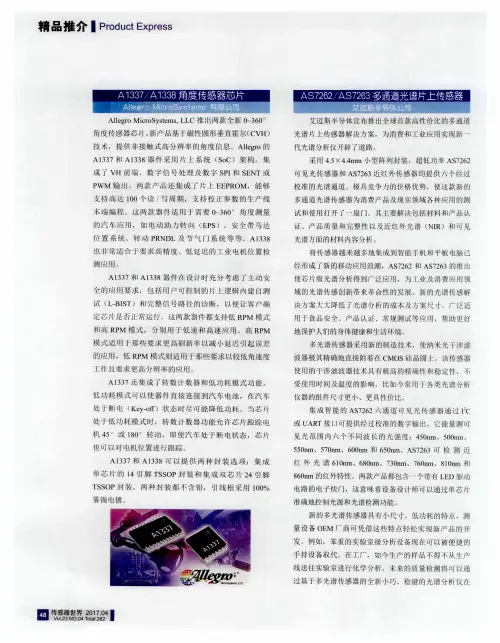
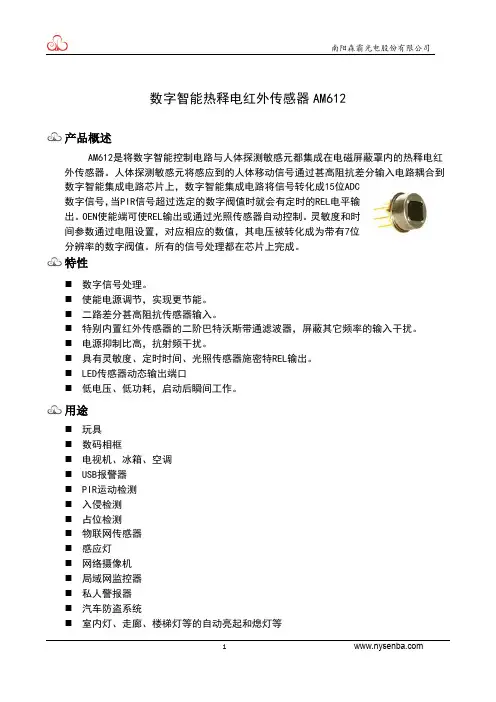
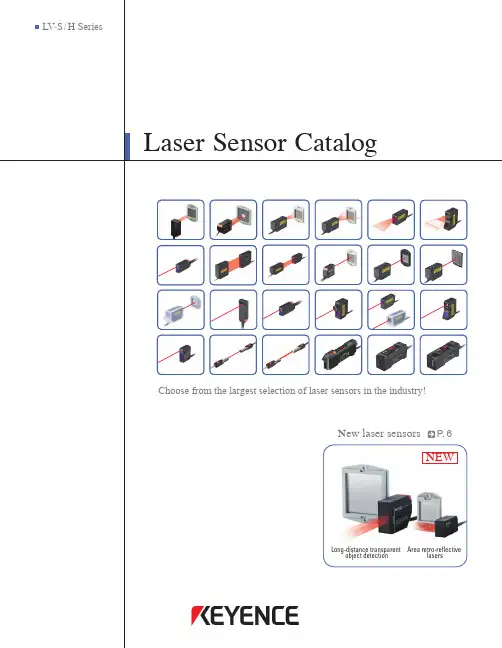
Choose from the largest selection of laser sensors in the industry!NEWLong-distance transparent object detection Area retro-reflectivelasers2Product compositionLaser sensor featuresThe LV Series are digital laser sensors consisting of both a sensor head and an amplifier.Please note that the supported amplifier unit depends on the sensor head.• Compact size• Transparent object detection (available) • Zero datum function (available)• High-power• Waterproof (available)• 0.39"/1.18" 10 mm/30 mm area• Analog outputReflective/Retro-ReflectiveThrubeamLV -S SeriesLV -H SeriesLV -H SeriesVisible beam allows for easy installation Stable target detection from a remote location Small beam spot ensures high precisionSensor head LV-11SB LV-12SBAmplifierSensor head LV-21A LV-22A LV-20AAmplifierSensor head LV-51M LV-52AmplifierNEW NEW3Selecting a beam shapeMethod of detectionSpecific sensor headAmplifierSelect an LV Series laser sensorSelect an LV Series laser sensor according to these selection stepsSTEP 4SPECIFICATIONSDIMENSIONSEffective for wide detection ranges, such as when the target’s position varies as it passes through the beam.Small Beam SpotEffective for highly precise detection of minute targets.Area BeamThe shape of the laser beam emitted on the target forms a small spot.The shape of the laser beam emitted on the target forms a line.P.5Retro-ReflectiveP.4Product selection guideSelecting a beam shapeSelect a laser sensor head, either an area beam or small beam spot, according to the target that is to be detected.4LV-S63NEW NEW NEWMethod of detectionSelect either a reflective, retro-reflective, or thrubeam sensor based on the application.Area BeamReflectiveRetro-ReflectiveP.9LV-H100LV-H300LV-H110object detectionP.65Small Beam SpotRetro-ReflectiveLV-S71LV-S72LV-H62LV-H67LV-H62FLV-H35(H35F)P.12STEP 3STEP 4SPECIFICATIONSDIMENSIONSSelect an LV Series laser sensor6Area Beam Retro-ReflectiveArea LaserLV-S621.69"42.80.49"12.4All models support the P.R.O. function. The polarizing filter reduces direct reflected light from a mirrored-surface target.1. Numbers not enclosed in parentheses are the detecting distance for area spot. Numbers enclosed in parentheses are the detecting distance for small beam spot.2. Numbers not enclosed parentheses are the detecting distance when an accessory reflector is used. Numbers enclosed in parentheses are the detecting distancewhen OP-51428 (sold separately) is used.(Note) We recommend that, when LV-S62 is used for glass detection, the detecting distance be set to 3.3' (1 m) or less.0.91"231.82"46.20.49"12.40.91"When installing the rear mountingbracket (sold separately)Using all of the mounting brackets allows you toadjust the optical axis right, left, up, and down.Reversed mounting0.54"13.60.75"191.50"382.52"640.86"21.81.73"44NEWOP-84350When installing the rear mountingbracket (sold separately)OP-84349When installing the rear mountingbracket (sold separately)OP-84351 Stable detection is possible due to the wide beameven if the target's position varies.Use this switch to selectarea spot or small beam spot.AreaSmallBe sure to use the dedicated mounting brackets because optical axis adjustment is required.Side view shape andsmall sizeReflectorR-6L (accessory)Product featuresSelecting a specific sensor headSelect a sensor head tailored to your application.Reversed mountingReversed mountingNEW7The beam shining on a target is clearly visible.Reflector R-6 grey (accessory)Reflector R-6 grey (accessory)Options Long-Distance AreaWide AreaLong-Distance Transparent Object DetectionLV-S63LV-H64LV-H65Distance (inch mm)200 400 600 800 1000Detection distance – area width characteristics(typical example)Area width (inch mm)50 100 150 200 250 300t=0.03" 0.7 mm50 mmAt a distance of approx. 3.94" (100 mm) width is approx. 1.97" (50 mm).NEWReflected light levels are averaged by widening the acceptance surface (approx. 1.26"x 0.59" 32 x 15 mm). This provides stable transparent object detection.Easy optical axis adjustmentDetecting distance98.4'30 mReflectorR-9 (accessory)for LV-H64 and H65(Note) We recommend that, when LV-S62 is used for glass detection, the detecting distance be set to 11.5' (3.5 m) or less.Area width (inch mm)Distance (inch mm)NEWNEWSTEP 3STEP 4SPECIFICATIONSDIMENSIONSSTEP 2When the mounting bracket is attached (accessory)Detection distance – area width characteristics(typical example)When the mounting bracket is attached (accessory)When the mounting bracket is attached (accessory)Select an LV Series laser sensorNEWWhat sets the LV-S62/S63 apart from conventional sensors for transparent object detection?Area laserBeam ShapeArea beams are excellent for detecting targets with gaps.Small spotLarge light quantity variation if position shiftsArea beamSmall light quantity variation even if position shiftsUnlike small beam spots, area beams are less affected by vibrating targets or backgrounds.LV-S63 also spreads the spot’s depth 0.31" 8 mm x 0.47" 12 mm to provide more stability.High-frequency superimposition drive circuitLaser BeamThe amplifier cancels light quantity variation.The zero datum function always monitors the received light quantity when there is no transparent object and keeps the displayed value at 0 (light quantity variation cancellation). If a transparent object is input, the function displays the difference. This makes it very easy for the LV Series amplifier to stably detect transparent targets.Can stably detect vibrating/inclining transparent targetsDue to the characteristics of lasers, the slightest incline of a transparent target can cause light diffraction resulting in unstable detection. The newly-developed laser drivecircuit found in the LV-S62 and LV-S63 compensates for this phenomenon.World‘s first zero datum functionAmplifierWhereas most lasers use a single wavelength, the LV-S62/S63 uses high-frequency superimposition technology to take a wide range ofwavelengths. This has enabled the practical elimination of transparent quantity changes.LV-11SB/12SBAmplifier unitNEW(Patent pending)Reflector8STEP 3STEP 4SPECIFICATIONSDIMENSIONSSTEP 2Selecting a specific sensor headSelect a sensor head tailored to your application.Area Beam Reflective1.38"0.49"0.79"12.420350.49"1.36"1.04"CharacteristicsLV-H47LV-H47LV-H4220406080100Received light quality (digit)120140Characteristics of received light quantity and distance (typical example)Characteristics of detecting distance and area width (typical example)Distanceinch (mm)Distance inch (mm)Widthinch(mm)Width inch(mm)Product features Long DistanceDefinite ReflectiveLV-L02An area width can be selected.The area becomes thicker.When the mounting bracket Select an LV Series laser sensor9Distance inch (mm)Standard /High Power (0.39" (10 mm) wide)LV-B101(Mounted vertical)LV-B102(Mounted horizontal)LV-B301(Mounted vertical)LV-B302(Mounted horizontal)OFF: Ignores small targets.ON: Responds to targetswith complete lightinterruption(2 brackets to 1 set)(2 brackets to 1 set)1247.44142.52034.2122041.3Example using the LV-H110The sensitivity of the LV-H100 has been increased. The LV-H100detects only targets that completely interrupt light.Up/Down adjustment is possible Easy optical axis adjustmentvia visible beamYou can clearly see the beambecause a light diffuser sheet isinserted into the end of thereceiver. This makes opticalaxis adjustment extremelyeasy.Mounting brackets providebeam position adjustment.Two types of mounting bracketsare available: Brackets formounting vertically and bracketsfor mounting horizontally. Be sureto use the dedicated mountingbracket because optical axisadjustment is necessary.LV-H100/110Standard (1.18" (30 mm) wide)LV-H300When the mounting bracketis attached (accessory)When the mounting bracketis attached (accessory)When the mounting bracketis attached (accessory)When the mounting bracketis attached (accessory)1.63"0.47"0.79"0.79"0.47"1.35"1.67"120.47"0.47"1.87"1.61"411.61"Area Spot ThrubeamSelecting a specific sensor headSelect a sensor head tailored to your application.Product features10(2 brackets to 1 set)(2 brackets to 1 set)ApplicationEnvelope printing check Area retro-reflective (wide)Sheet break detection Shaft arrival checkWorkpiece not inserted properlyLV-H42LV-H47LV-H65LV-H64Area spotHigh-power area spot thrubeam Presence/Absence detection of target in bag High-power area spot thrubeamSeal number countingSelect an LV Series laser sensorSTEP 3STEP 4SPECIFICATIONSDIMENSIONSSTEP 2Area thrubeam (1.18" (30 mm) wide)Workpiece location detection Area thrubeam (0.39" (10 mm) wide)Cotton looseness/cut detectionABNGOKNGLV-H300LV-H100LV-H110LV-H110Selecting a specific sensor headSelect a sensor head tailored to your application.Small Beam Spot Retro-ReflectiveDifference from fiber sensorCharacteristics*All models support the P .R.O. function. The polarizing filter reduces direct reflected light from a mirrored-surface workpiece.46.915.83612.42318Characteristics of detecting distance and spot diameter (typical example)Characteristics of detecting distance and spot diameter (typical example)Spot diameter (inch mm)LV-S61Distance(feet m)0.91"0.71"0.49"1.42"12.40.49"361.42"0.62'1.85'1.05"0.02"0.04"0.06"0.08"0.10"0.12"0.14"0.16"20001500100050012345678Select an LV Series laser sensorSTEP 3STEP 4DIMENSIONSSTEP 2SmallLong Distance (up to 164' (50 m))Product features and mounting brackets* The detecting distance remains unchanged even if the reflective tape is used.P.29LV-S61LV-H67StandardLV-H62W aterproof: IP67LV-H62FP.32P.32P.33P.32–P.3351.2t=0.03"130GlassFluorine-contained rubberFluoroplastic (PFA)Fluoroplastic (PFA)When the mounting bracket is attached (accessory)When the mounting bracket is attached (accessory)Reflector (accessory)Reflector (option)When the mounting bracket is attached (accessory)When the mounting bracket is attached (accessory)2.02" 5.12"Small Beam Spot ReflectiveSelecting a specific sensor headSelect a sensor head tailored to your application.CharacteristicsCharacteristics of setting distance and spot diameter (typical example)Spot diameter (Mil µm)Distance (inch mm)Distance(inch mm)Characteristics of detecting distance and minimum spot diameter (typical example)Spot diameter(inch mm)LV-H32LV-H3725130.49"12.40.49"12.40.49" 12.40.41" 10.40.911.30" 0.87"1.42"1.85"0.62"15.81.05"26.61.36"34.51.04" 26.51.04" 26.51.26" 0.51"0.24"0.98"0.24"40030020010075655545859510535Select an LV Series laser sensorSTEP 3STEP 4DIMENSIONSSTEP 2 Small Small Side-ViewSmall Adjustable Distance Setting Adjustable Beam SpotCoaxial StructureWaterproof: IP67Ultra-small Beam Spot (1.97 Mil (50 μm))Also lockableAdjustments aresecured using thelens position lockfeature.With the coaxialstructure, the LV-H35 canreceive reflected lighteven from a small gap.LV-S41 (S41L)LV-H32LV-H35FLV-H37LV-S31MaterialAccessoryAdjustable by handSpot adjustment can be easily madeby turning the focus ring by hand.GlassFluorine-contained rubberFluoroplastic(PFA)Product features and mounting bracketsWhen the mountingWhen the mounting bracketis attached (accessory)When the mounting bracketWhen the mounting bracketis attached (accessory)When the mounting bracketis attached (accessory)When the mounting bracketis attached (accessory)The supplied magnifyingglass enables users to checkthe beam spot position.Small Beam Spot ThrubeamSelecting a specific sensor headSelect a sensor head tailored to your application.Each symmetrical mounting bracket (two sets)(2 brackets to 1 set)Product featuresSmall Beam SpotLV-S71Step DifferentiationLV-S721.19" 30.2M61.19" 30.2M6High-precision differentiationThe receiver side uses a slit with a width of 0.02" (0.6 mm), allowing high-precision differentiation.Easy optical axis adjustmentOptical axis adjustment is easy becausethe spot diameter is approx. 0.02" (0.6 mm) and19.69" (500 mm) ahead of the transmitter (large spot).Small type mounting bracket (option)OP-66869The optical axis can be adjusted from above.Side viewer attachment(option) LV-F1The optical axis can be adjusted from above.Operation indicatorBoth the transmitter and receiver are equipped with an operation indicator.Ultra-smallLV-S71 is the smallest red laser sensor in its class.TransmitterTransmitterReceiverReceiverWorld’s SmallestSelect an LV Series laser sensorDetection of the presence/absence of a part (spot welding)Glass detection Detection of work pieces remaining in the mold.Small beam spot thrubeam (small, M6)Floating cover detection Rack stop position detectionCounter inputSmall beam spot retro-reflective (long distance)Protrusion detectionSmall beam spot thrubeam (small, M6)De-burr checkingNGOKLV-H32LV-S41LLV-H35LV-S31LV-S61LV-S71LV-S71LV-H67Small beam spotApplicationSTEP 3STEP 4SPECIFICATIONSDIMENSIONSSTEP 2Usually* the first digit of the digital display will drift when there is no workpiece. The zero datum function* clears the display to 0, eliminating this drifting status. (Returning to the nominal display when light isPopular DSC functionUnique form dust coverEasily adjustable large Secure head connectionPart names and featuresThe LV-S Series, comes with the world’s first zero datum function.The LV-S Series comes with the DSC function.LV-S SeriesExpansion unitMain unit1.24" 78.6 3.09"* For external input, select "light emission stop", "tuning", "set value bank selection" or "received light quantity shift." Up to 16 expansion units can be installed to one main unit.The main unit comes with an amplifier mounting bracket.The expansion unit comes with an end unit.Connectable sensor headsSelecting an amplifierWhen using one amplifier, select the main unit. When using two or more amplifiers, select one main unit and one or more expansion units.LV-H SeriesReflective or Retro-ReflectiveSelect an LV Series laser sensorSTEP 3STEP 4SPECIFICATIONSDIMENSIONSSTEP 2Expansion unitMain unitExpansion unitMain unitThe main unit comes with an amplifier mounting bracket.The expansion unit comes with an end unit.The main unit comes with an amplifier mounting bracket.The expansion unit comes with an end unit.1.12" 65.82.59"0.79" 20Connectable sensor heads*1 The LV-20A is also available to support the zero line. (It does NOT have a cable for power or outputs).*2 external inputs on the expansion units can be used for calibration. However, laser emission stop input cannot be used on the expansion units. Up to seven additional expansion units can be installed for each main unit.1.12" 74.62.94"0.79" 20*1 Laser emission stop input on the main unit only.Up to seven additional expansion units can be installed for each main unit.1.12" 28.565.8 2.59"0.79" 20Main unitConnectable sensor heads(Note) Only the LV-H41 and LV-H51 can be used with the LV-11A amplifier.LV-H Series ThrubeamVisible light semiconductor laserLV-S626.6' 2 m 32.8' 10 m (16.4' 5 m)26.2' 8 m (11.5' 3.5 m)16.4' 5 m (6.6' 2 m)LV-S SeriesLV-S71LV-S729.84" 250 mm15.75" 400 mm* IEC60825-1 based classification is made according to FDA (CDRH) Laser Notice No. 50 Regulations.* The parentheses indicate the detecting distance when the small beam spot is used.* Contains a symmetrical mounting bracket (two in total).Visible light semiconductor laserLV-S71LV-S7219.69" 500 mm* Contains a symmetrical mounting bracket (two in total).Specifications21Laser emission stop input/External calibration input/Setting value bank selection input/Received light intensity shift inputLV-11SB/12SB2.LV-11SBP/12SBP2.1. The LV-11SB only2. Black: Control output 1, white: Control output 2* The LV-11SB only 1. The LV-11SBP only2. Black: Control output 1, white: Control output 2* The LV-11SBP onlyAmplifierHSP: 80 µs FINE: 250 µs TURBO: 500 µs SUPER: 2 ms ULTRA: 4 ms (LV-S62 and LV-S63 can ONLY be used with amplifiers ending with B or BP.)1. LV-S62 and LV-S63 can ONLY be used with amplifiers ending with B or BP.2. Numbers for the LV-S31 are four in standard mode and two in high-speed mode.3. To connect several units they must be mounted on a METAL DIN rail. Ensure that the output current is 20 mA max. With several units connected, the allowable ambient temperature range varies as follows:1 to2 units connected: 14 to 131ºF (-10 to +55ºC)3 to 10 units connected: 14 to 122ºF (-10 to +50ºC) 11 to 16 units connected: 14 to 113ºF (-10 to +45ºC)4. When more than 8 units connected, be sure to use supply voltage 24 VDC Ripple (P-P) 10% max.Output circuitInput circuitLV-S SeriesSPED 1: 500 µs SPED 2: 2ms SPED 3: 8 ms SPED 4: 32 msSTEP 3STEP 4SPECIFICATIONSDIMENSIONSSTEP 2Input/Output CircuitsSpecifications22Straight-Beam, Retro-ReflectiveVisible light semiconductor laser Wavelength: 650 nm 2.76" ±0.59"5.91" 150 mm Small Beam SpotInvisible light semiconductor laser Wavelength: 785 nm 9.84" 250 mm Visible light semiconductor laser Wavelength: 650 nm6.6' 65.6' 20m ⅡVisible light semiconductor laser Wavelength: 650 nm3.94" to 19.69" (3.94" to 27.56") 100 to 500 mm (100 to 700 mm) 3.94"(5.91") 100mm (150 mm)7.87" to 33.46" (11.81" to 39.37") 0.39" to 5.91" (0.39" to 9.84") Class ⅡVisible light semiconductor laser Wavelength: 650 nmLV-H Series23Expansion unit (1 line)FINE: 80 µs/ TURBO: 500 µs/ SUPER TURBO: 4 ms280 µs to 4.7 msFINE: 500 µs/ TURBO: 2 ms/SUPER TURBO: 8 msNPN (PNP) open-collector x 2 channels, 40 VDC (30 V) max., max. 100 mA, residual voltage (1.0 V max.)1. To connect several units they must be mounted on a METAL DIN rail. Ensure that the output current is 20 mA max. With several units connected, the allowable ambient temperature range varies as follows:2. When 2 to 5 expansion units are additionally installed: 14 to 122˚F (-10 to +50˚C ). When 6 or 7 expansion units are additionally installed: 14 to 113˚F (-10 to +45˚C ).LV-L01 Specifications (lens attachment for LV-H42) (Unit: inch mm)LV-L02 Specifications (lens attachment for LV-H47) (Unit: inch mm)Main unit Expansion unit (0 line)Main unitSTEP 3STEP 4SPECIFICATIONSDIMENSIONSSTEP 2LV-H SeriesSpecifications24LV-H SeriesThrubeam0.39" 10 mmVisible light semiconductor laser Wavelength: 650 nm* Use a dedicated mounting bracket to install the sensor.1. To connect several units they must be mounted on a METAL DIN rail. Ensure that the output current is 20 mA max. With several units connected, the allowable ambient temperature range varies as follows:When 2 to 5 expansion units are additionally installed: 14 to 122ºF (-10 to +50ºC ). When 6 or 7 expansion units are additionally installed: 14 to 113ºF (-10 to +45ºC ).SUPER 4 ms25LV-H / LV-S SeriesCAD DATA Download Service/cadDimensionsSTEP 3STEP 4SPECIFICATIONSDIMENSIONSSTEP 2Analog output circuit for monitoring Laser radiation interruption (main unit only)External calibration input* Orange (monitor output) only for LV-51M* Orange (monitor output) only for LV-51MPLV-21A/11A/51MLV-21AP/51MPLV-22A/52LV-22AP/52PLV-21AP/51MPLV-21A/11A/51M(LV-51M/51MP only)Input/Output Circuits3Unit: inch mmReflector R-6L (Specifications / Dimensions26LV-S SeriesOP-84350L-shaped mounting bracket for LV-S62 (Option)OP-84349Rear mounting bracket for the LV-S62 (Option)Mounting bracketattachedMounting bracketattached18.819.5130.90.9Material: Stainless steelt=0.06" t=1.5Accessory screwM3, P=0.5× 7.3…1pieceMaterial: Stainless steel56110.06" 1.5Material: Stainless steelt=0.06" t=1.5Accessory screwsM3, P=0.5× 5…1pieceMaterial: Stainless steelM3, P=0.5× 16.5…1pieceMaterial: Stainless steelM3, P=0.5× 18…2pieceMaterial: Stainless steelAccessory nutM3…1 pieceMaterial: Stainless steelUnit: inch mm27DimensionsLV-S SeriesCAD DATA Download Service/cadRear mounting bracket for LV-S63 (Accessory)Mounting bracket attachedMounting bracket OP-84351Side mounting bracket for LV-S62 (Option)Material: Stainless steel t=0.08" t=2.0Accessory screws M4, P=0.7× 30…3piece Material: Stainless steel Accessory nut M4…3 piece48.8 2.2 13 STEP 1STEP 3STEP 4SPECIFICATIONSDIMENSIONSSTEP 2Unit: inch mm28LV-S31Mounting bracket for LV-S41/LV-S41L (Accessory)Installed bracketon the LV-S41Installed bracket on the LV-S41LCenter of Distance setting*Accessory screwsM3, P=0.5× 0.59" 15 …2piece Material: Iron (nickel-plated)LV-S SeriesUnit: inch mmInstalled bracketon the LV-S41L4t=1.0Dimensions LV-S SeriesCAD DATA Download Service /cadSTEP 1STEP 3STEP 4SPECIFICATIONSDIMENSIONSSTEP 22930LV-S SeriesUnit: inch mmDimensionsLV-11SB/11SBPLV-12SB/12SBPMounting bracket attached (LV-11SB and LV-11SBP DIN rail accessory)End unit(included with LV-12SB/LV-12SBP)When several units are connected(13)LV-S SeriesCAD DATA Download Service /cadSTEP 1STEP 3STEP 4SPECIFICATIONSDIMENSIONSSTEP 266Unit: inch mm31LV-H Seriesmm1.58.617.232335Material: Stainless steel t=0.05" t=1.2Material: Stainless steel t=0.06" t=1.5DimensionsLV-H SeriesCAD DATA Download Service/cadSTEP 1STEP 3STEP 4SPECIFICATIONSDIMENSIONSSTEP 2Unit: inch mm345.9Slit (Black)Slit (Grey)When mounting LV-L02LV-H47Slit seal (included with LV-L02)5.4LV-H Series610.5Unit: inch mm359.53177.52 x ø0.07"DimensionsLV-H SeriesSTEP 1STEP 3STEP 4SPECIFICATIONS DIMENSIONSSTEP 2CAD DATA Download Service/cadUnit: inch mm363.5LV-20A14.5min.LV-22A /22APEnd unit(included with LV-22A/22AP )When several units are connected:(0.17" x 0.13")(4.4 x 3.4)Mounting bracket attached (included with LV-21A/11A)min.LV-21A/21AP/11Aexpansion units.ø0.18" ø4.5, 6-core x Brown/Blue: 0.34 mmLV-H SeriesUnit: inch mm6637LV-H SeriesSTEP 1STEP 3STEP 4SPECIFICATIONSDIMENSIONSSTEP 2DimensionsCAD DATA Download Service/cadUnit: inch mm38LV-B301Plate nut for transmitter635LV-B302(Mounting bracket for LV-H300, included twobrackets for the transmitter and receiver.)4.535196Supplied screws:M3 × 0.71" 18 …(2 pcs.)Material: Stainless steelt=0.06" t=1.540.73"Supplied screws:M3 × 0.71" 18 …(2 pcs.)Material: Stainless steelt=0.06" t=1.5LV-H SeriesUnit: inch mm39(22.6) expansion units.Mounting bracket attached LV-51M/51MPEnd unit(LV-52/52P accessory)When several units are connected:74.6LV-H SeriesSTEP 1STEP 3STEP 4SPECIFICATIONSDIMENSIONSSTEP 2DimensionsCAD DATA Download Service/cadUnit: inch mm© KEYENCE CORPORATION, 2008 LVSBG-KA-C-E 0028-1 600140 Printed in JapanKA1-0038Specifications are subject to change without notice.CALL TOLL FREETO CONTACT YOUR LOCAL OFFICE1-888-539-3623Corporate Office 50TiceBlvd.,WoodcliffLake,NJ07677Phone:201-930-0100Fax:201-930-0099E-mail:*******************■ Regional offices CO FL GA ILDenver Tampa Atlanta ChicagoAL CA CA Birmingham N.California Los AngelesVA WARichmond SeattleSC TN TN TXGreenville Nashville Knoxville DallasFax : 201-930-0099www.keyence .comKEYENCE CORPORATION OF AMERICAKEYENCE CANADA INC.Head Office Phone:905-696-9970Fax:905-696-8340E-mail:*******************Montreal Phone:514-694-4740 Fax:514-694-3206KEYENCE MEXICO S.A. DE C.V.Phone:+52-81-8220-7900 Fax:+52-81-8220-9097 Email:*************************IN KS KY MAIndianapolis Kansas City Louisville BostonMI MI MN MODetroitGrand Rapids Minneapolis St. LouisNJ NY NC NCWoodcliff Lake Rochester Charlotte RaleighOH OH OR PACincinnati Cleveland Portland Philadelphia。
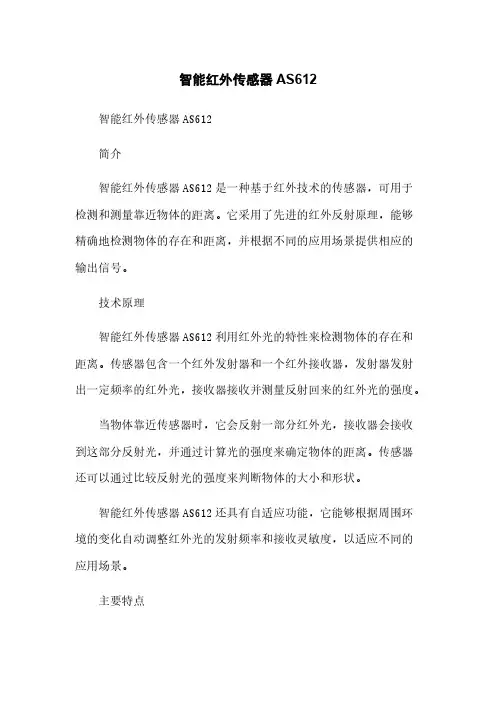
智能红外传感器AS612智能红外传感器AS612简介智能红外传感器AS612是一种基于红外技术的传感器,可用于检测和测量靠近物体的距离。
它采用了先进的红外反射原理,能够精确地检测物体的存在和距离,并根据不同的应用场景提供相应的输出信号。
技术原理智能红外传感器AS612利用红外光的特性来检测物体的存在和距离。
传感器包含一个红外发射器和一个红外接收器,发射器发射出一定频率的红外光,接收器接收并测量反射回来的红外光的强度。
当物体靠近传感器时,它会反射一部分红外光,接收器会接收到这部分反射光,并通过计算光的强度来确定物体的距离。
传感器还可以通过比较反射光的强度来判断物体的大小和形状。
智能红外传感器AS612还具有自适应功能,它能够根据周围环境的变化自动调整红外光的发射频率和接收灵敏度,以适应不同的应用场景。
主要特点1. 高精度测量智能红外传感器AS612具有高精度的测量能力,能够精确地检测物体的存在和距离。
其测量误差小,可靠性高。
2. 快速响应时间传感器具有快速的响应时间,能够迅速检测到物体的存在。
这使得它在需要快速反应的应用场景中非常有用。
3. 宽工作温度范围智能红外传感器AS612具有宽工作温度范围,可以在较低或较高温度条件下正常工作。
这使得它在各种环境中都能够稳定运行。
4. 自适应功能传感器具有自适应功能,能够根据周围环境的变化自动调整红外光的发射频率和接收灵敏度。
这使得传感器在不同的应用场景下都能够获得最佳的性能。
5. 简单易用智能红外传感器AS612具有简单易用的特点,可以方便地集成到各种设备中。
它还提供了丰富的接口和配置选项,以满足不同用户的需求。
应用领域智能红外传感器AS612在许多领域中都有广泛的应用,包括但不限于以下几个方面:1. 自动化控制传感器可以用于自动化控制系统中,用于检测物体的存在和距离,并根据检测结果进行相应的控制操作。
例如,可以用于自动门、智能照明系统等。
2. 安防监控传感器可以用于安防监控系统中,检测人体的靠近或离开,并在需要时触发相应的报警或视频录像等操作。
微信扫描二维码关注“萤石智能生活订阅号”快速操作安装电池1.打开电池盖。
按照图示方向,滑下探测器背面的电池盖。
2.拉出绝缘片。
拉出电池槽中的绝缘片。
3.合上电池盖。
重新合上电池盖和底座,电池安装完成。
请配合萤石设备(如A1C、R2和C1S等,需另行购买)使用。
添加到萤石设备方式一:通过二维码添加:1.2.登录“萤石云视频”手机客户端,从主菜单进入扫描界面。
扫描探测器背面的二维码,根据提示将探测器添加到萤石设备(需连接网络)上。
开启关联探测器模式 1扫描二维码2萤石将不断推出支持添加探测器的产品,具体添加方式请参考产品的用户手册或者登录萤石官网查询。
方式二:通过注册信号添加:1.2.开启关联探测器模式:A1和A1C短按功能键即可;R2和R2S需要通过显示器登录萤石云账户,进入详情界面,开启关联探测器模式。
将探测器拿到距离萤石设备50cm以内,短按一下机身上的按键,此时注册信号被成功触发。
开启关联探测器模式1触发注册信号250cm以内俯100°安装探测器您可以将探测器安装在靠近阳台、窗户的天花板或者1.选择安装位置。
建议将探测器安装在距离阳台或者窗帘大于50cm、距离地面高度不低于1.8m的位置。
选择安装位置时请注意:不可安装在户外高温、低温下不可使用避免阳光直射不可靠近电风扇2.安装底座:用泡棉胶或者螺丝将底座固定在选定位置(安装平面请保持光滑、整洁)。
如果使用泡棉胶安装如果使用螺丝安装3.安装探测器:将旋转球头和探测器依次安装到底座上。
4.调整角度:调整探测器的机身,将机身上的箭头指向室内,即入侵方向。
安装旋转球头1安装探测器2维护当探测器的电池电量低时,探测器将发送一个低电量警告消息到“萤石云视频”客户端,提醒您及时更换电池(更换电池时请注意正负极)。
5.测试:安装完成后您可以在测试范围内来回走动,调整探测器的角度和位置。
从入侵方向进入时,探测器的指示灯红色闪烁,关联的萤石设备接到一个报警消息;若10秒内再次检测到人体活动,探测器不发送报警信号并且顺延10秒。
智能楼道灯——红外传感器(教案)2023-2024学年综合实践活动六年级上册全国通用一、教学内容本节课主要介绍了红外传感器的工作原理和应用,以及如何利用红外传感器设计制作智能楼道灯。
通过本节课的学习,学生可以了解红外传感器的基本知识,掌握红外传感器的使用方法,并能够运用所学知识解决实际问题。
二、教学目标1. 知识与技能目标:了解红外传感器的工作原理和应用;学会使用红外传感器设计制作智能楼道灯。
2. 过程与方法目标:培养学生动手操作能力和创新思维能力;提高学生合作交流和解决问题的能力。
3. 情感态度与价值观目标:激发学生对科学技术的兴趣和好奇心;培养学生节能环保意识。
三、教学难点1. 红外传感器的工作原理及其在实际生活中的应用。
2. 智能楼道灯的设计与制作。
四、教具学具准备1. 教具:PPT、红外传感器、智能楼道灯电路图、实验器材等。
2. 学具:每组一套红外传感器、智能楼道灯制作材料、电工工具等。
五、教学过程1. 导入新课:通过展示红外传感器在生活中的应用,如遥控器、自动门等,引发学生对红外传感器的兴趣。
2. 讲解原理:介绍红外传感器的工作原理及其在智能楼道灯中的应用。
3. 演示实验:演示如何使用红外传感器制作智能楼道灯,引导学生观察实验现象,总结实验原理。
4. 分组讨论:学生分组讨论如何设计制作智能楼道灯,教师巡回指导。
5. 制作实践:学生根据讨论结果,动手制作智能楼道灯。
6. 成果展示:学生展示自己制作的智能楼道灯,互相交流学习。
7. 总结评价:教师总结本节课所学内容,对学生制作的智能楼道灯进行评价。
六、板书设计1. 智能楼道灯——红外传感器2. 内容:(1)红外传感器的工作原理及应用(2)智能楼道灯的设计与制作(3)学生作品展示与评价七、作业设计1. 完成实验报告:要求学生记录实验过程、实验现象和实验原理。
2. 创新设计:鼓励学生利用所学知识,设计制作其他红外传感器应用作品。
八、课后反思本节课通过讲解红外传感器的工作原理和应用,以及引导学生动手制作智能楼道灯,使学生对红外传感器有了更深入的了解。
红外避障传感器简介红外避障传感器介绍(反射型)日期:2006-5-16 14:05:14 来源: 点击: 1572 添加到收藏夹实图:技术指标:主体外形尺寸:23×15.3×15.1mm(长×宽×高)重量:7g额定电压:直流电源5.0V检测范围(反射面为白色木板):1~ 40cm(挡板为白色时检测距离在40cm时达到临界点,超过此数值后检测效果变差)调节方式:多圈电阻式调节,逆时针方向旋转功率变小,顺时针方向旋转功率变大返回值:有信号(高电平)返回值为“1”,无信号(低电平)返回值为“0” 状态指示方式:检测到信号指示灯亮红灯,无信号不亮安装方式:单颗Ø3螺丝安装线长:17.4cm?0.2cm(有效距离)连接方式:单条3芯排线,2510型3脚插头有效角度:30:左右原理与功能红外避障传感器(以下简称红外)。
红外具有一对红外信号发射与接收二极管,发射管发射一定频率的红外信号,接收管接收这种频率的红外信号,当红外的检测方向遇到障碍物(反射面)时,红外信号反射回来被接收管接收,经过处理之后,通过数字传感器接口返回到机器人主机,机器人即可利用红外波的返回信号来识别周围环境的变化。
应用介绍:红外是通过发射端发射红外信号,接收端接收由障碍物反射回来的红外信号,来判断是否有障碍物。
项目应用红外避障传感器在很多项目中都有使用。
在初中灭火、高中搜救项目中,机器人可以通过红外避障传感器走迷宫;在轨迹项目中,机器人可以通过黑、白色对红外线的反射和吸收值不同而用红外避障传感器来识别黑色的轨迹线。
注意事项:1、红外是数字传感器,红外接收管只有在接收到一定强度的红外信号时才会有数值的变化。
障碍物(反射面)太小时,红外会检测不到;障碍物(反射面)颜色为黑色或深色时,会被吸收大部分的红外信号,而只反射回一小部分,导致红外接收管接收到的红外信号强度不够,不足以产生有障碍物(反射面)的信号。
红外、6122编码、38KHz载波一、红外遥控编码简介一般而言,一个通用的红外遥控系统由发射和接收两大部分组成,如图1 所示:发射部分主要包括键盘矩阵、编码调制、红外发射管;接收部分包括光、电信号的转换以及放大、解调、解码电路。
举例来说,通常我们家电遥控器信号的发射,就是将相应按键所对应的控制指令和系统码( 由0 和1 组成的序列),调制在32~56kHz 范围内的载波上(目的为:抗干扰及低功率),然后经放大(接三极管)、驱动红外发射管(透明的头)将信号发射出去。
二、6122编码格式简介流行的控制方法是应用编/ 解码专用集成电路芯片来实现。
不同公司的遥控芯片,采用的遥控码格式也不一样。
本文是NEC(代表芯片WD6122)PWM( 脉冲宽度调制) 标准。
遥控载波的频率为38kHz( 占空比为1:3) ;当某个按键按下时,系统首先发射一个完整的全码,然后经延时再发射一系列简码,直到按键松开即停止发射。
简码重复为延时108ms,即两个引导脉冲上升沿之间的间隔都是108ms。
如图2所示即为完整的NTC编码。
正常发码:引导码(9ms+4.5ms)+用户编码+用户编码(或者是用户编码的反码)+键数据码+键数据反码+延时:将正常发码标识出来,从图中可以看出“0”和“1”的表示方法。
(不要问为什么是这样,规定!标准!高性能!)重复码:9ms+2.25ms+延时三、程序思想①低功耗。
写程序前要想到,没有用过的,可以新建工程只用sleep命令;②需要知道用户编码(客户码),每个键对应的编码,这些都是自己或者客户设定的;③高电平期间:用38KHz的方波表示,低电平期间:用低电平表示。
也就是说,高电平不是一直都是高,其实是38KHz的方波,这也是为什么上面②和③图中9ms高电平期间有方格。
(我用的公司自己的精简指令集,就不再上传。
需要的话,私信)四、电路做为波形的输出端,加三极管,放大。
下图为矩形键盘组成的按键,图中黑色二极管为红外发射管。
as7265x工作原理
AS7265x是一种多光谱传感器解决方案,它能够检测从紫外线到近红外线的光谱。
AS7265x系列传感器由三个不同的芯片组成,分别是
AS72651(UV)、AS72652(VIS)和AS72653(NIR),它们共同构成了一个18通道的多光谱感测阵列,覆盖了410纳米至940纳米的波长范围。
这个系列的传感器可以广泛应用于各种光谱传感应用,如环境监测、农业、化学分析等领域。
具体来说,AS7265x系列的工作原理如下:
1. 多通道光谱检测:AS7265x系列通过其18个通道来检测不同波长的光,每个通道都对应特定的光谱范围,从而能够捕捉到丰富的光谱信息。
2. 集成控制器:在这三个芯片中,AS72651负责覆盖600纳米至870纳米的近红外波长,并作为整个传感器组的主控制器。
3. 光谱数据输出:AS7265x系列传感器可以输出各个通道的光谱数据,这些数据可以被用来分析和识别物质的光谱特性。
此外,AS7265x系列传感器可以与Arduino等微控制器配合使用,通过相应的驱动代码来实现光谱数据的采集和处理。
这样的设计使得AS7265x成为一种灵活且功能强大的光谱传感器,适用于多种应用场景。